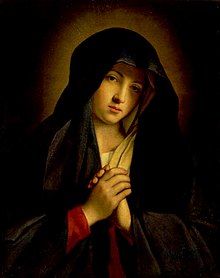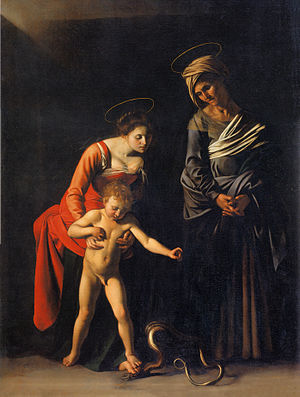禮拜天美術神遊 (68) :The Madonna and Child with St. Anne (Dei Palafrenieri).法國母親節羅孚宮選畫 Madonna with the Green Cushion painted by Andrea Solario ca. 1507-1510.
https://www.facebook.com/hanching.chung/videos/4518605448150227
Blessed Virgin Mary

Our Lady of Sorrows, by
Giovanni Battista Salvi da Sassoferrato, 17th century
Born c. 18 BC
[1]Died after c. 30/33 AD
Spouse(s)
JosephChildren
Jesus,
[a] possibly the
brothers and sisters of JesusParent(s)
Joachim and
Annehttps://en.wikipedia.org/wiki/Mary,_mother_of_Jesus
Virgin in Oxford Companion To ART
---Virgin, the Blessed :至聖童貞聖母。
Virgin Mary :童貞瑪利亞:通常稱 Blessed Virgin Mary ,簡稱 B.V.M. 。
Artwork of the week

 As it is Mother’s Day in France, discover Madonna with the Green Cushion painted by Andrea Solario ca. 1507-1510.
As it is Mother’s Day in France, discover Madonna with the Green Cushion painted by Andrea Solario ca. 1507-1510. The relationship established between the two figures, the dialogue of their respective gazes, the complicity of their postures all display the maternal tenderness to a child. The absence of the traditional holy attributes emphasizes the mere representation of the Christ child in his mother’s arms. Solario builds a scene unveiling the intimate and familiar moment of a mother nursing her child.
The relationship established between the two figures, the dialogue of their respective gazes, the complicity of their postures all display the maternal tenderness to a child. The absence of the traditional holy attributes emphasizes the mere representation of the Christ child in his mother’s arms. Solario builds a scene unveiling the intimate and familiar moment of a mother nursing her child. Madonna with the Green Cushion, a devotional image of the Virgin nursing Jesus, has been so called since the 17th century due to the motif of the green cushion placed on a marble plinth in the foreground. This detail, perfectly integrated here within the holy group, is indeed remarkable; with its soft, padded comfort it truly accompanies this scene of family well-being.
Madonna with the Green Cushion, a devotional image of the Virgin nursing Jesus, has been so called since the 17th century due to the motif of the green cushion placed on a marble plinth in the foreground. This detail, perfectly integrated here within the holy group, is indeed remarkable; with its soft, padded comfort it truly accompanies this scene of family well-being. Solario's salient characteristics are the velvety softness of the rendering of the skin, the shimmering saturation of the colors, and the naturalism of the landscape elements. Round forms and a feeling of natural ease are combined in this firm yet gentle work. It is one of Solario's masterpieces, painted either during his stay in France from 1507 to 1510 or just after his return to Italy.
Solario's salient characteristics are the velvety softness of the rendering of the skin, the shimmering saturation of the colors, and the naturalism of the landscape elements. Round forms and a feeling of natural ease are combined in this firm yet gentle work. It is one of Solario's masterpieces, painted either during his stay in France from 1507 to 1510 or just after his return to Italy.-

© 2005 Musée du Louvre / Jean-Gilles Berizzi
From Wikipedia, the free encyclopedia
Jump to navigationJump to searchThe Madonna and Child with St. Anne (Dei Palafrenieri) is one of the mature religious works of the Italian Baroque master Caravaggio, painted in 1605–1606, for the altar of the Archconfraternity of the Papal Grooms (Italian: Arciconfraternita di Sant'Anna de Parafrenieri)[1] in the Basilica of Saint Peter.[2] The painting was briefly exhibited in the parish church for the Vatican, Sant'Anna dei Palafrenieri, before its removal, presumably due to its unorthodox portrayal of the Virgin.[3] It was subsequently sold to Cardinal Scipione Borghese, and now hangs in his palazzo (Galleria Borghese), where it shares space along with five other Caravaggios: Boy with a Basket of Fruit, David with the head of Goliath (attributed to 1606), Young Sick Bacchus, Saint Jerome Writing, and St John the Baptist in the Desert.
While not his most successful arrangement, it is an atypical representation of the Virgin for its time, and must have been shocking to some contemporary viewers. The allegory, at its core, is simple. The Virgin with the aid of her son, whom she holds, tramples on a serpent, the emblem of evil or original sin. Saint Anne, whom the painting is intended to honor, is a wrinkled old grandmother, witnessing the event. Flimsy halos crown the upright; the snake recoils in anti-halos. Both Mary and Jesus are barefoot; Jesus is a fully naked uncircumcised child. All else is mainly shadow, and the figures gain monumentality in the light.
If this painting was meant to honor the grandmother of Christ, it is unclear how the ungracious depiction of her wrinkled visage in this painting would have been seen as reverent or iconic. Further shock must have accrued, as stated by Bellori, at the Virgin Mary's revealing bodice. One could speculate that the parallel diagonals of Jesus’ phallus and leg suggest that both battle the snake, with one its metaphorical equal.
Other works[edit]
The model for the Virgin can also be found in Caravaggio's Madonna di Loreto. Contrast this tense scene with the famous, more peaceful arrangement of the family by Leonardo in his Virgin and Child with St. Anne.
Madonna, Child and Serpent by Caravaggio. c. 1605-1606
Madonna ( It. ): (1) 聖母抱耶穌像。 (2) 聖母:原為義大利文,即英文之 Our Lady 。
***
The Virgin and Child with Saint Anne is an unfinished oil painting of c. 1503 by Italian Renaissance artist Leonardo da Vinci depicting Saint Anne, her daughter the Virgin Mary and the infant Jesus.[1] Christ is shown grappling with a sacrificial lamb symbolizing his Passion as the Virgin tries to restrain him. The painting was commissioned as the high altarpiece for the Church of Santissima Annunziata in Florence and its theme had long preoccupied Leonardo.[citation needed]
History[edit]
It is likely that the painting was commissioned by King Louis XII of France following the birth of his daughter Claude in 1499, but it was never delivered to him.[1] Leonardo probed into incorporating these figures together by drawing the Burlington House Cartoon (National Gallery).[1] In 2008, a curator at the Louvre discovered several faint sketches believed to have been made by Leonardo on the back of the painting.[2][3][4] Infrared reflectography was used to reveal a "7-by-4 inch drawing of a horse's head", which had a resemblance to sketches of horses that da Vinci had made previously before drawing The Battle of Anghiari. Also revealed was a second sketch 61⁄2 inch-by-4 inch depiction of half a skull. A third sketch showed the infant Jesus playing with a lamb, which sketch was similar to that which is painted on the front side.[2] The Louvre spokesperson said that the sketches were "very probably" made by Leonardo and that it was the first time that any drawing had been found on the "flip side of one of his works". The drawings will be further studied by a group of experts as the painting undergoes restoration.[2]
Content and composition[edit]
Leonardo's painting is at once both pleasing, calm yet confusing upon closer examination. The composition of the three figures is fairly tight, with the Virgin Mary clearly interacting with the infant Jesus. Upon closer examination of their positioning it is apparent that Mary is sitting on Saint Anne's lap. It is unclear what meaning this could have and what meaning Leonardo intended to project with that pose. There is no clear parallel in other works of art and women sitting in each other's lap are not a clear cultural or traditional reference that the viewer can relate to. Additionally, although the exact sizes of neither the Mother Virgin nor Saint Anne are known, it can be extrapolated from the painting that Saint Anne is a significantly larger person than Mary. This subtle yet perceptible distortion in size was utilized by Leonardo to emphasize the mother–daughter relationship between the two women despite the apparent lack of visual cues to the greater age of Saint Anne that would otherwise identify her as the mother. The child is holding a lamb. We also see that Mary is gazing into her child's eyes, while Saint Anne is looking at Mary. As Mary is sitting on her lap and Saint Anne is looking at her, it is possible that Leonardo was trying to make a point about their relationship and personalities.
Freud's interpretation[edit]

The "vulture" theorized by Freud
Sigmund Freud undertook a psychoanalytic examination of Leonardo in his essay Leonardo da Vinci, A Memory of His Childhood. According to Freud, the Virgin's garment reveals a vulture when viewed sideways. Freud claimed that this was a manifestation of a "passive homosexual" childhood fantasy that Leonardo wrote about in the Codex Atlanticus, in which he recounts being attacked as an infant in his crib by the tail of a vulture. Freud translated the passage thus:"It seems that I was always destined to be so deeply concerned with vultures – for I recall as one of my very earliest memories that while I was in my cradle a vulture came down to me, and opened my mouth with its tail, and struck me many times with its tail against my lips."
Unfortunately for Freud, the word 'vulture' was a mistranslation by the German translator of the Codex and the bird that Leonardo imagined was in fact a kite, a bird of prey which is also occasionally a scavenger. This disappointed Freud because, as he confessed to Lou Andreas-Salomé, he regarded Leonardo as "the only beautiful thing I have ever written". Some Freudian scholars have, however, made attempts to repair the theory by incorporating the kite.
Another theory proposed by Freud attempts to explain Leonardo's fondness of depicting the Virgin Mary with Saint Anne. Leonardo, was raised by his blood mother initially before being "adopted" by the wife of his father Ser Piero. The idea of depicting the Mother of God with her own mother was therefore particularly close to Leonardo's heart, because he, in a sense, had "two mothers" himself. It is worth noting that in both versions of the composition (the Louvre painting and the London cartoon) it is hard to discern whether Saint Anne is a full generation older than Mary.
2011 cleaning controversy[edit]
On 7 October 2011 Le Journal des arts [fr], a Paris art publication, reported that the restoration posed more danger to the painting than was previously expected.[5] In late December 2011 and early January 2012 reports emerged that Ségolène Bergeon Langle, the former director of conservation for the Louvre and France’s national museums, and Jean-Pierre Cuzin, the former director of paintings at the Louvre, both of the advisory committee supervising the painting’s restoration, had resigned[6] over a painting cleaning controversy, with critics claiming that the painting has been damaged by being cleaned so it became brighter than the artist ever intended.[7] Other experts spoke out in favour of the cleaning treatment.[8]
See also[edit]










